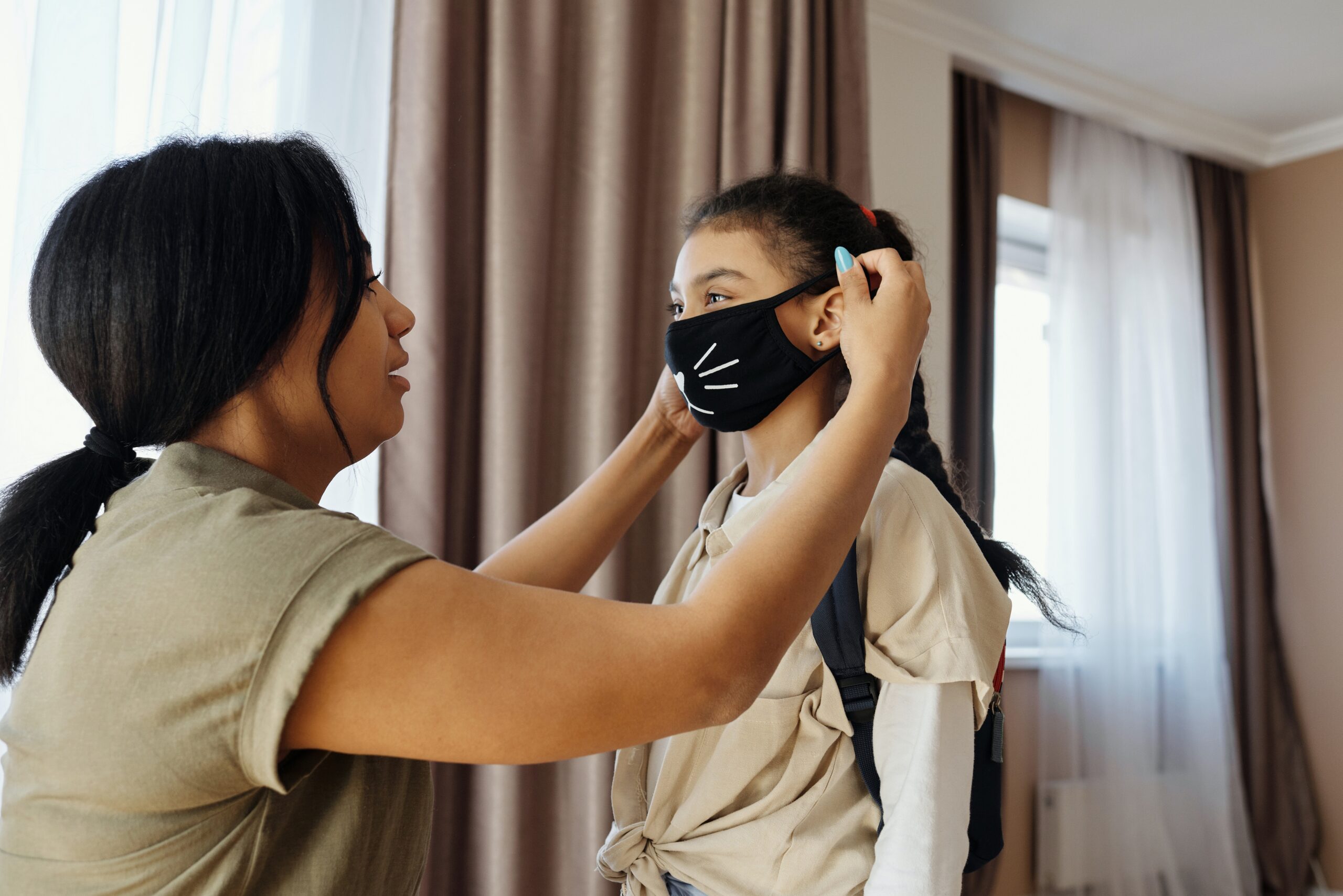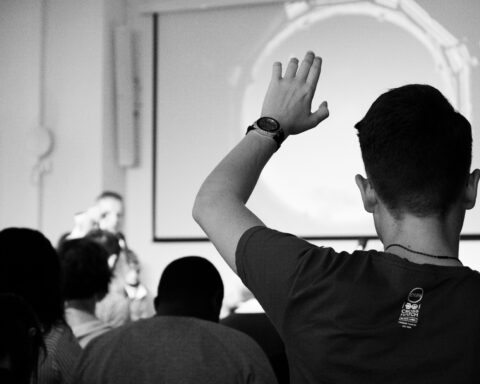On March 21, Ontario’s students returned to class at the end of March Break for in-person classes and without masks for the first time since the pandemic began two years ago.
Since March 21, masks have not been required in places like schools, restaurants, gyms and movie theatres across the province.
While many people are relieved to have COVID-19 restrictions eased up, some parents, teachers and medical experts have expressed concerns about children in classrooms without masks. Only 56 per cent of kids aged 5-11 have received at least one dose of a COVID-19 vaccine, as of Apr. 21. By comparison, 93 per cent of Ontarians 12-years-and-older are at least partially protected from the virus.
Potential delays in social development
Levels of concern have increased since March as many places in Canada are in the grips of the sixth wave. The combination of eased restrictions and increased levels of infection has led to increased absences and staff shortages across the country. Some school boards and even individual schools have re-imposed their own mask mandates despite the provincial requirement being dropped.
Children have been limited from settings like family gatherings, playdates, recreational activities, and school for much of the pandemic. And when those things have happened, they’ve often been under drastically different circumstances. Some doctors in Ontario have said children and teens have suffered from “social malnutrition” during the pandemic.
“One of my big concerns is that there are far fewer opportunities for kids to develop their social and emotional skills than is normal,” says Dr. Michal Perlman.
Perlman is a professor in the Department of Human Development and Applied Psychology at the University of Toronto’s Ontario Institute for Studies in Education. She studies how the quality of interactions children experience in early childhood impacts their development.
Perlman says that interventions like masking are crucial to preventing the spread of COVID-19, but is concerned about how protective measures could affect children in the long term. New Canadian Media spoke to Perlman in December 2021, ahead of the winter break amidst an Omicron-fuelled fifth wave.
Children could experience delays developing social skills as a result of spending their formative years navigating COVID-19 protections, Perlman worries.
“We’re going to get a cohort of kids who’ve had much less opportunity for social interactions during a really critical phase in development where kids learn a lot from the social exchanges they have.”
Learning while navigating COVID-19 interventions
Interacting with others is critical for young children’s development as it gives them opportunities to learn skills like sharing, conflict resolution, theory of mind, and communication, Perlman explained. Social interaction is the primary learning method for young children.
Perlman admitted the scientific community writ large isn’t sure at this point what the consequences of masking will be on children’s learning outcomes but she suspects masks present a learning barrier for kids because only half the face is visible (with the exception of transparent masks).
“Researchers are trying to test kids’ abilities to read faces when someone’s wearing a mask,” said Perlman. “Because if that’s what kids are getting exposed to in childcare then that’s what they have an opportunity to learn from.”
Children begin language acquisition very early. One of the ways children learn a language is by watching their caregivers’ mouths when they speak. Studying caregivers’ faces is also one of the ways children learn about emotions and body language. This suggests that not being able to see a caregiver’s mouth could hinder learning.
Online and “simultaneous learning” have also been introduced in Ontario in order to mitigate the spread of COVID-19 while still educating kids. Simultaneous or hybrid learning refers to teachers instructing classes consisting of a mixture of in-person and virtual students at the same time.
People opposed to hybrid learning say that it compromises the quality of education students receive, similar to the argument often made for smaller class sizes. Some argue that neither students nor teachers benefit from the hybrid method due to issues like divided attention and technological hiccups.
Struggles for students and caregivers
Virtual-only learning comes with its own share of negative aspects too. Research has shown that students learn from one another in addition to their instructors. Critics of online learning question whether virtual classrooms can provide the same complexity and richness that in-person classes offer and that is essential for learning.
Perlman is involved in a longitudinal study in collaboration with the City of Toronto on low-income families with young children. The study has been ongoing for years, so, Perlman and her colleagues saw this as an opportunity to examine how the pandemic was affecting these families by comparing data from before and during the first few months of the pandemic.
Around 80 per cent of the parents they surveyed reported that their child experienced difficulties with virtual learning. Perlman said respondents reported their child’s biggest challenges with online learning were motivation and attention in addition to missing in-person social interaction. Similar rates of caregivers also said they were struggling in their dual role of parents and education facilitators on top of dealing with personal challenges like managing their work-life balance and their mental health.
Perlman noted that “young kids pick up on maternal depression,” she also said that traits such as a caregiver with a flat affect can be reflected in the child. Perlman suggests that parents be mindful of signs their child might be suffering from anxiety or depression such as disrupted sleep patterns and a loss of appetite or interest in their usual hobbies.
“When you’re stressed, depressed, anxious, it’s a lot harder to be that warm, responsive, attuned caregiver that is optimal for kids. What we’re seeing here are the kinds of experiences for [caregivers] that would erode their parenting. What I’m worried about is that if we come back a year later, the kids may be doing worse.”
In this study, the strengths and difficulties questionnaire was used to measure a child’s mental well-being and functioning by looking at five categories: social problems, emotional problems, conduct disorders, pro-social behaviour, and hyperactivity. The questionnaires conducted in May 2020 found that 38 per cent of respondents appeared to be doing better since the onset of the pandemic.
These children scored lower in 3-out-of-5 categories in the strengths and difficulties questionnaire after the onset of the pandemic then they did before the pandemic. This means their mental health improved as a result of the pandemic. While Perlman says she’s glad to see improvement in certain areas for some students, she’s disappointed it took a pandemic for those gaps to be addressed.
“It makes me wonder what these kids were not getting from their environments before the pandemic that this circumstance was better for them?”
In most cases, research shows that children who were doing well before the pandemic continued to do well, and COVID-19 made those who struggled more vulnerable, and often they did worse.
Perlman stressed that she isn’t suggesting that the pandemic is good for some kids. She pointed out that the trends seen early in the pandemic on the subject may not hold true over time. However, she did say it’s important to pay attention to areas where children showed improvement and to structure education in such a way that these children can continue to thrive when in-person classes return.
Perlman said we must also be mindful of the children who are disadvantaged when we’re re-thinking how to improve education and mitigate the effects of living through a pandemic. She worries failing to do so will result in children falling behind.
“I worry that the gap for the disadvantaged kids is going to widen because well-resourced families are in a better position to compensate for what’s going on in the environment,” Perlman said. “Existing disadvantage is going to be compounded by the challenges that their parents face and how they can cope with them.”
A widening gap
Over the last two years, the pandemic has often made marginalized communities more vulnerable to both the direct and indirect impacts of COVID-19.
According to York University education professor, Sarah Barrett, teachers aren’t sure how they can help students catch up on vital life skills. Barrett noted that teachers feared most for students with special needs, those living in poverty, racialized and Indigenous students, and English-language learners.
“They know that the students that need the most are the ones that aren’t getting what they need,” Barrett told Global News.
In the aforementioned Global News article, Carleton University neuroscience professor, Amedeo D’Angiulli, said there’s no question academic disruptions have had detrimental impacts on children’s emotional, physical, social and mental well-being. He said the cumulative effect of these impacts further hinders brain function.
D’Angiulli also predicts more developmental and learning disorders to arise due to a combination of delayed medical screenings and school interventions. Other experts say early intervention is critical to rectifying some of these issues.
The Kids Help Phone reported that they’re receiving twice the amount of calls and texts than they did in 2019.
Some parents and educators have suggested having students repeat a grade to ensure that the curriculum has been thoroughly taught and the kids meet the necessary academic standards to remain competitive. This was the case for the Garden Hill First Nation’s students.
Perlman isn’t in favour of holding kids back in order to make sure they achieve academic outcomes.
“I think we should just provide a lot more support rather than say well the solution is to hold the kids back and pretend like they just need to have that,” she suggested. “People are very resilient and we need to capitalize on that but that’s not to say that we don’t need to move quickly in terms of public policy to support all kids and families but especially the disadvantaged families.”
Perlman said she’s thankful that the various levels of government have stepped in to provide financial aid to support low-income families.
“Those kinds of interventions have been really meaningful. It’s not an exaggeration to say that in some cases that they are life saving interventions,” she said.
Marcus is a poet, editor and freelance journalist based in Toronto. He currently works with New Canadian Media as an Editor and as a Freelance Writer for ByBlacks.com, The Edge: A Leader's Magazine and The Soapbox Press.




